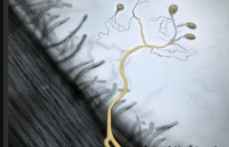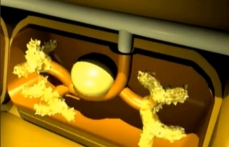Transcription of video clip Cells and other organisms
Endomycorrhizal symbiosis
Gigaspora gigantea fungus and barrel medic roots (Medicago truncatula)

© Jardin botanique de Montréal
The fungus, in yellow. The root, in gray.
Exchanges of nutrients between the Gigaspora gigantea fungus and the host plant take place deep inside the plant's roots.
How does the fungus manage this?

© Andrea Genre
In beige, the appressorium. In yellow, the root's cells.
When it contacts a root's surface, the fungus forms a sort of suction pad called an appressorium. The plant quickly reacts.
The epidermal cells prepare to be penetrated. Their nuclei react to the chemical signals from the fungus and surround it with a special compartment.
The fungus easily traverses the cells and makes its way to the root's inner bark.
Once the fungus reaches the inner cells, it goes into the spaces between the cells. The adjacent cells react to its presence and let it in.
Gigaspora has succeeded. These colonized cells are in direct contact with the endoderm.
The endoderm controls exchanges of nutrients between the root's bark and its conducting tissues.

© Andrea Genre
Around the round nucleus, the arbuscules.
Inside these cells, the fungus forms ramifications that increase the surface for exchanges between the partners.
It is here, inside these arbuscules, that nutrients are exchanged. In exchange for glucose, the fungus provides the plant with water and minerals extracted from the soil.
Many trees establish mycorrhizal symbioses such as barrel medic's that was shown here.
Back to video clip




